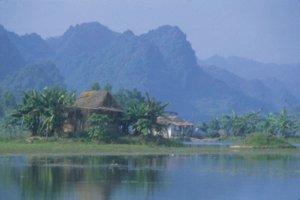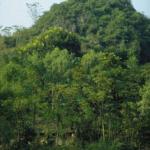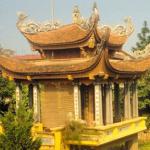Lost and Found in My Duc
Like a life-size replica of Ho Chi Minh, the old bearded gentleman tips his beret, then speaks in fluent French. As far as I can make out, he explains that he lives in the house behind the old Buddhist temple that I've stopped to photograph. He goes on to say that this temple has stood since the ninth century, making it over a thousand years old.
This structure, stark in its simplicity, stands in the middle of a lotus-covered lake, on Cho Dâu Road near My Duc, about 50 kilometers southeast of Hanoi.
"I'm looking for Dá Thuot Cave", I had asked at the My Duc road junction, when two cheeky kids jumped on the back of my motorbike and pointed somewhere along a side-road. About three kilometers later, when they asked to be dropped off, I found they had pointed in the wrong direction.
I was pondering on how to clobber two kids to death without arousing the attention of the locals, when this gracious temple appeared out of nowhere. It was like one of those enticing clues that you find on a treasure hunt.
I'd left Hanoi on a motorbike, with no other clues than a tatty brochure issued by the Ha Tay province Tourism Department. This brochure sung the praises of the "undiscovered wonders" of this province, "as beautiful as brocade and flowers, the homeland of silk." In addition, there was a brief mention of My Duc town in the Lonely Planet guide, which raves about the "Perfume Pagoda" to which My Duc is the gateway.
Tours to the Perfume Pagoda (Chua Huong) leave from some of the travelers' cafés in Hanoi. For $15, you get to share a minibus with a group whose company you would go out of your way to avoid back home. This time, I thought "no, thanks!" Instead, I chose the glorious freedom of a Honda "Dream Machine", on hire throughout Hanoi for $US 10 a day.
Mastering motorbike riding in Vietnam is not difficult. You just forget that you have a body and follow the stream. You soon find that underlying the seeming chaos of Vietnamese traffic is a sense of order and that even at peak hours the flow is smooth, like water around rocks in a river.
From Hanoi, the main road leads southwest. Hà Dong, the capital of Ha Tay province, is just twelve kilometers from Hanoi. Just past Hà Dong you veer left towards Vân Dinh, and here's where the Vietnamese countryside starts to open up.
The road from Hà Dong to Vân Dinh is as good an example of intensive farming as you'll find anywhere. As if in a watercolor painting by an oriental Brueghel, everyone seems to be doing something: watering gardens, building dikes, or tending rice crops. A dozen different varieties of vegetables are grown along the banks separating the rice plots and ducks are an effective means of insect control. Over each group of fields, temples and ancestral graves keep silent watch.
The road passes through a village, and I stop for a lunch break at a roadside stall. A group of layabouts are laying about. I sit down, and they produce a plastic can full of "water" and proffer a glass. It is water, too - pure firewater! I start to wonder whether you get a free seeing-eye dog with every glass, when mine is topped up again. This process is repeated over and over, as though it's their solemn duty to get me drunk, and my solemn duty to comply. Eventually I manage to thank them for their hospitality, pay for the food and pour myself out the door.
For the next few klicks, the road is a blur. But the landscape around here is ample compensation for any feeling of disorientation. Limestone karst towers rise above the paddy fields, looking like petrified dragons rearing out of the plains. Geologists say that the conditions for the formation of karst are just right in these tropical regions. The high relief of the landscape allows rapid vertical drainage, and the rainfall is heavy enough to act as a solvent, the carbon dioxide in the rain converting the limestone into soluble calcium bicarbonate. Whatever the physics and chemistry, this karst landscape forms a stunning backdrop to the sylvan beauty of the paddy fields. And at the foot of this mountain-sized karst, a peaceful lotus-strewn lake meanders through the fields.
Fortunately, I still had hold of the Ha Tay tourism brochure. A picture in the brochure showed a group of rowers negotiating the "Hang Truot Cave", past a landscape strikingly similar to that which rose before my eyes. I asked directions once more, and after a couple more false leads and circuitous diversions, was at last led along a narrow path through the paddy fields.
And here at last was a sign over a portal framing an even narrower path: "Khu Du Lich Quan Son" (Lake Quan Son Tourist Area). Tourist? Do they ever get any "tourists" here? This place is so difficult to find that it seems to have been deliberately concealed from view.
We travel along the pathway to a boathouse perched alongside the lake. Here, over cups of green tea, I try to explain in my best three-word Vietnamese that I'd like to take a boat around the lake. They scratch their heads in non-comprehension, until I produce the brochure.
Now, all is smiles. The head boatman points to one of the pictures in the brochure. "That's me!" he says. Indeed, there is a certain resemblance. The picture was obviously taken thirty years ago when he still had hair and teeth.
Eventually, we set out for a tour. This is a wondrous area, each lotus-beflowered basin of the lake leading into another basin still more beautiful. And over all, the limestone towers form a jagged silhouette against the sky, as though they've been cut out with a giant saw.
This is a BIG lake, and you'd need many hours to see it all. Some of the main sights are Dá Thuot Cave, Dá Ngoc Long Cave, Bai Tae Island - and right at the other end of the lake - Chua Huong: the Perfume Pagoda!
I never did get to see the Perfume Pagoda. In order to have seen it, it would have been helpful to have approached it from the right direction. Evidently, this day the dice weren't predestined to roll in this direction.
But getting lost in Vietnam can be a blessing in disguise. The clash between the "excess baggage" that you bring with you (in the form of preconceptions) and what you receive in return can be profoundly liberating. The Vietnamese have the uncanny knack of being able to cut through cultural barriers and treat you purely at face value.
In the process, you find just a little bit more of yourself.
* * * * *
Fact File
Entry Requirements:
U.S. passports are valid for travel in Vietnam. Generally, visitors' visas will not be renewed after one month's stay in Vietnam. Current visa information may be obtained from the Embassy of Vietnam, 1233 20th Street NW, Suite 400, Washington, DC 20036, telephone 202-861-2293 or 202-861-0694, fax 202-861-1297, or from a travel agent that organizes travel to Vietnam.
Web Site: www.VietnamEmbassy-USA.org
Note: Embassy contact information updated 11/01/02
Motorbike Hire:
Good quality Japanese bikes are on hire throughout Hanoi: ask at your hotel. Going price is $US10 a day. Gasoline costs just 3,400 dong (US 30¢) a liter.
Boat Hire:
To hire a rowboat at Quan Son Lake (tel 0134 47261) costs $US 5 an hour; for a speedboat, bargain around $10-12 an hour.
Where to Stay ' Hanoi:
(Hanoi area code=4) Hanoi, formerly with a dearth of good accommodations, is now undergoing a hotel boom. Many 4-star and 5-star establishments are under construction. A range of hotels, from luxury to budget, is given here, with prices in $US: Sofitel Metropole, the grand olde hotel of Hanoi, 15 Ngo Quyen St, tel 26 6919, fax 26 6920, $US200 single or double.
Bao Son Hotel, opened in November 1995, 2 Lang Trung Street, tel 35 3536, fax 35 5678, 4-star comforts, Australian general manager, $US120-180, plus 15% taxes.
Hoang Ngoc (Oriental Pearl) Hotel, elegantly furnished, just 14 rooms: a true boutique establishment, tel 23 2660, fax 23 2605, $US29-59 (including buffet breakfast), plus 15% taxes (note: they give a 20% discount if you stay a year or longer!).
Camellia Hotel, my favorite hotel in Hanoi, but you won't find it in any of the guide books: excellent and friendly service, 81 Thuoc Bac Street, tel 28 2376, fax 28 2404, $US15-17 including breakfast, for clean rooms with 9-channel satellite TV. Queen Café and Guest House, 65 Hang Bac Street, good café very popular with travelers (this can be a plus or a minus), and with very basic rooms attached, tel 26 0860, $US4-15.
Where to Stay ' Ha Tay Province:
(Ha Tay Province area code=34)
Ha Tay province is not yet really set up for tourism. There is a basic hotel in Vân Dinh, and at the other (NW) end of the province the intriguing Huong Rung (Forest Scent) Hotel at Tan Linh, near Ba Vi (tel 32605).
Note:
Country Code for Vietnam is +84
* * * * *
 ThingsAsian
ThingsAsian



















